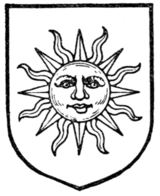Scotland is of five points unless a greater number are specified. But mullets pierced and unpierced of six (Fig. 548) or eight points (Fig. 549) are frequent enough in English armory.
The Scottish practice differs, and it must be admitted that it is more correct than the English, though, strange to say, more complicated. In Scottish armory they have the estoile, the star, and the mullet or the spur-revel. As to the estoile, of course, their practice is similar to the English. But in Scotland a straight-pointed charge is a mullet if it be pierced, and a star if it be not. As a mullet is really the "molette" or rowel of a spur, it certainly could not exist as a fact unpierced. Nevertheless it is by no means stringently adhered to in that country, and they make confusion worse confounded by the frequent use of the additional name of "spur-rowel," or "spur-revel" for the pierced mullet. The mullet occurs in the arms of Vere, and was also the badge of that family. The part this badge once played in history is well known. Had the De Veres worn another badge on that fatal day the course of English history might have been changed.
 Fig. 548.—Mullet of six points. |
 Fig. 549.—Mullet of eight points. |
 Fig. 550.—Sun in splendour. |
The six-pointed mullet pierced occurs in the arms of De Clinton.
The Sun in Splendour—(Fig. 550) always so blazoned—is never represented without the surrounding rays, but the human face is not essential though usual to its heraldic use. The rays are alternately straight and wavy, indicative of the light and heat we derive therefrom, a typical piece of genuine symbolism. It is a charge in the arms of Hurst, Pearson, and many other families; and a demi-sun issuing in base occurs in the arms of Davies (Plate VI.) and of Westworth. The coat of Warde-Aldam affords an example of the Rays of the sun alone.
A Scottish coat, that of Baillie of Walstoun, has "Azure, the moon in her complement, between nine mullets argent, three, two, three and one." The term "in her complement" signifies that the moon is full, but with the moon no rays are shown, in this of course differing from the sun in splendour. The face is usually represented in the full moon,
